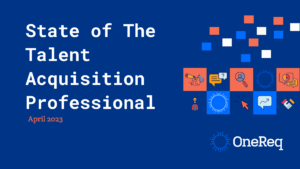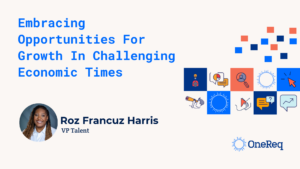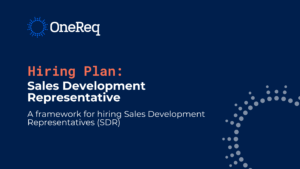This article is a framework that can be used by recruiters and sales hiring managers to plan and execute the hiring of a Business Development Representative properly. It will provide an understanding of the role and suggested candidate profile for the Recruiters and an interview plan for the Hiring Managers.
Understanding the Role
Business Development Representative, shortened to BDR, forms the foundation of many outbound sales organizations. These individuals are generally tasked with prospecting for new customers, cold outreach (by phone, email, etc), and supporting multiple account executives to hit their sales targets. The BDR role generally differs from a Sales Development Representative (SDR) because it focuses on outbound sales primarily but, depending on the size of the company, BDR may also handle qualifying warm leads.
BDRs likely target a specific region or industry depending on their alignment. In many SaaS businesses, the BDR is not a closing role, meaning they are not responsible for completing a sale or measured on the deals closed. However, a BDR will still carry a monthly and/or quarterly quota based on outreach numbers (e.g., outbound calls/emails), calls scheduled with account executives, to name a few categories they are measured against. Common tools that the role uses are CRMs (e.g. Salesforce, Oracle), sales execution platforms (e.g. Outreach.io, Hubspot, Groove, Salesloft, Zoominfo), and conversation intelligence tools (e.g. Revenue.io, Gong, Fireflies.ai).
Plan & Prep
Understand the Sales Style
It is important to understand the How and Why of the sales function. The How is important because some companies may have a preferred method of how they sell or reach out (e.g. email vs. phone) so a specific trait (e.g. written communication) may have a higher premium than other skills (e.g. cold calling). The Why is important because certain people might resonate more with the product they are selling than others. Understanding these will help you find the right candidates, especially ones that will grow within an organization.
Business Model & Sales Process
Business-to-Business (B2B) has a different style and structure when compared to Business-to-Consumer (B2C) sales. It is important, as the recruiter, to understand the difference between the two as well as a loose understanding of the deal structures and the differing sales tactics/methodologies. This knowledge will ensure that the candidate you are looking for has the right persona for the role. For example, a candidate that has strong written communication is likely a better fit for a role that requires written reach out as opposed to cold calling.
Align Interview Process to Real Work
One of the best indicators of real-life performance is to ask someone to attempt the work. To that end, give your BDR a business example like “you see that XYZ Company has received a new round of funding. Write a three email cadence to the CTO to get them interested in our product.” The point of this exercise is to see if the BDR digs into the research to discover ways your product differentiates from others in the space and how it can drive value for the potential customer. Because outbound is vital for the role, this is a great way for the hiring manager to gauge a candidate’s research and creativity. If you know the role will require cold calling, you can build off that exercise and do a role-play during the onsite interview.
Candidate Profiles
Given that this is a fairly entry-level role, you will likely be hiring for skills rather than professional experience. Some skills to look for are:
- Conciseness
- Resilience
- Coachable
- Organized
Bonus points can be awarded for prior experience with the sales tools in use.
Interview Plan
Below is an example interview Structure you can use as a template.
Example Interview Structure
Stage One: Intro Call (30-45 minutes)
Standard review of resume and assessment of soft skills
Stage Two: Email Sequence Project
Hiring Manager (or designated team member) should review the email sequence and if it is good, the candidate moves forward. If it isn’t, the candidate could be declined. Another way is to have the review happens during the hiring manager interview.
Stage Three: Hiring Manager Call (45 minutes)
The emphasis of this interview should be to gauge the coachability, curiosity, and perseverance of the candidate. Prior to the interview, the hiring manager should review the email sequence project. A portion of the interview could then be spent reviewing the email sequence with the candidate and providing feedback.
Stage Four: Onsite (Depending on the Company – 2-3.5 hours with 2-3 parts)
Behavioral Interview (One or two 30-minute interviews)
This can be with a current BDR/SDR, or an Account Executive. The goal is to discuss the day-to-day and what the role is like as well as expectations and ways of working with different partners across the sales team and broader team (product, eng, etc) partnership and expectations.
Mock Call (45 Min) *If the role will require cold calling
First 15 minutes: Coaching session between the hiring manager and the candidate similar to what would happen in the company. The hiring manager should give the candidate the persona they are selling to and the candidate should be given the opportunity to ask questions about how to approach the call and possibly some questions to ask.
Middle 15 minutes: A mock call with the hiring manager acting as the buyer or another BDR/SDR from the team. During the call, the candidate should be evaluated for how they overcome objections and how quickly they think on their feet.
Last 15 minutes: Coaching session between the hiring manager and candidate to review the call and give them an honest evaluation/feedback.
Sales Leader (30-45 minutes)
This could happen on the same day or another day and is dependent on the organization. At smaller companies, heads of sales groups might want to have a chat with anyone coming into their organization. Consider this interview optional depending on the size of the company, bandwidth, and preferences of sales leaders.
Example Interview Questions
- Tell me about the last time you were rejected for something you really wanted. What did you learn from this experience and what did you do to improve for the next time?
- Have you ever had to cold-call or cold email in a past role? If so, what was the role? Are you comfortable doing X amount of calls per day?
- Walk me through how you stay organized.
- What was the last thing you taught yourself how to do?
- How might you cover for a coworker who might have missed a key aspect of the job?
- Describe a time when you were faced with a challenge with little to no understanding of how to deal with it. What was the situation, how did you overcome it, and what did you learn for the next time?
- When approached with a new tool or process that you are unfamiliar with, how do you go about learning more?obstacle course bounce house
- How would you describe your learning style?
- How do you like to receive feedback?
Hiring Plan is a series that provides frameworks and templates for use when recruiting specific roles.




